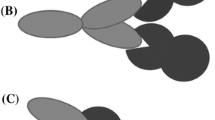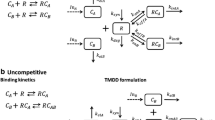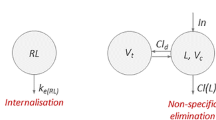Abstract
The target-mediated drug disposition (TMDD) model has been adopted to describe pharmacokinetics for two drugs competing for the same receptor. A rapid binding assumption introduces total receptor and total drug concentrations while free drug concentrations C A and C B are calculated from the equilibrium (Gaddum) equations. The Gaddum equations are polynomials in C A and C B of second degree that have explicit solutions involving complex numbers. The aim of this study was to develop numerical methods to solve the rapid binding TMDD model for two drugs competing for the same receptor that can be implemented in pharmacokinetic software. Algebra, calculus, and computer simulations were used to develop algorithms and investigate properties of solutions to the TMDD model with two drugs competitively binding to the same receptor. A general rapid binding approximation of the TMDD model for two drugs competing for the same receptor has been proposed. The explicit solutions to the equilibrium equations employ complex numbers, which cannot be easily solved by pharmacokinetic software. Numerical bisection algorithm and differential representation were developed to solve the system instead of obtaining an explicit solution. The numerical solutions were validated by MATLAB 7.2 solver for polynomial roots. The applicability of these algorithms was demonstrated by simulating concentration–time profiles resulting from exogenous and endogenous IgG competing for the neonatal Fc receptor (FcRn), and darbepoetin competing with endogenous erythropoietin for the erythropoietin receptor. These models were implemented in ADAPT 5 and Phoenix WinNonlin 6.0, respectively.







Similar content being viewed by others
References
Levy G (1994) Mechanism-based pharmacodynamic modeling. Clin Pharmacol Ther 56:356–358
Mager DE (2006) Target-mediated drug disposition and dynamics. Biochem Pharmacol 72:1–10
Kaushansky K (2006) Lineage-specific hematopoietic growth factors. N Engl J Med 354:2034–2045
Wang B, Nichol JL, Sullivan JT (2004) Pharmacodynamics and pharmacokinetics of AMG 531, a novel thrombopoietin receptor ligand. Clin Pharmacol Ther 76:628–638
Roopenian DC, Akilesh S (2007) FcRn: the neonatal Fc receptor comes of age. Nat Rev Immunol 7:715–725
Deng R, Loyet KM, Lien S, Iyer S, DeForge LE, Theil FP, Lowman HB, Fielder PJ, Prabhu S (2010) Pharmacokinetics of humanized monoclonal anti-tumor necrosis factor-{alpha} antibody and its neonatal Fc receptor variants in mice and cynomolgus monkeys. Drug Metab Dispos 38:600–605
Zalevsky J, Chamberlain AK, Horton HM, Karki S, Leung IW, Sproule TJ, Lazar GA, Roopenian DC, Desjarlais JR (2010) Enhanced antibody half-life improves in vivo activity. Nat Biotechnol 28:157–159
Mager DE, Jusko WJ (2001) General pharmacokinetic model for drugs exhibiting target-mediated drug disposition. J Pharmacokinet Pharmacodyn 28:507–532
Jin F, Liang M, Wang B, Vainshtein I, Schneider A, Chavez C, Lam B, Faggioni R, Roskos L (2011) Mechanism-based pharmacokinetic and pharmacodynamic modeling of MEDI-575, a monoclonal antibody directed against PDGFRalpha. In: Cynomolgus monkeys. American conference on pharmacometrics, San Diego, CA. http://www.go-acop.org/2011/posters
Yan X, Lowe P, Pigeolet E, Fink M, Berghout A, Balser S, Krzyzanski W (2011) Population pharmacokinetic and pharmacodynamic model of pharmacodynamics-mediated drug disposition (PDMDD) of erythropoiesis stimulating agent. In: American conference on pharmacometrics, San Diego, CA. http://www.go-acop.org/2011/posters
Mager DE, Krzyzanski W (2005) Quasi-equilibrium pharmacokinetic model for drugs exhibiting target-mediated drug disposition. Pharm Res 22:1589–1596
Gibiansky L, Gibiansky E, Kakkar T, Ma P (2008) Approximations of the target-mediated drug disposition model and identifiability of model parameters. J Pharmacokinet Pharmacodyn 35:573–591
Kenakin TP (2009) A pharmacology primer: theory application and methods. Elsevier, Burlington
Abramowitz M, Stegun IA (1964) Handbook of mathematical functions with formulas, graphs, and mathematical tables. U.S. Govt. Print. Off, USA
Selby SM (1975) Standard mathematical tables. Chemical Rubber Company Press, Florida
Press WH (1992) Numerical recipes in FORTRAN: the art of scientific computing. Cambridge University Press, Cambridge
Anton H, Grobe EM, Rorres C, Grobe CA (1994) Elementary linear algebra: applications version: student solutions manual. Wiley, New York
Hansen RJ, Balthasar JP (2003) Pharmacokinetic/pharmacodynamic modeling of the effects of intravenous immunoglobulin on the disposition of antiplatelet antibodies in a rat model of immune thrombocytopenia. J Pharm Sci 92:1206–1215
D’Argenio DZ, Schumitzky A, Wang X (2009) ADAPT 5 user’s guide: pharmacokinetic/pharmacodynamic systems analysis software. Biomedical Simulations Resource, Los Angeles
Vaccaro C, Zhou J, Ober RJ, Ward ES (2005) Engineering the Fc region of immunoglobulin G to modulate in vivo antibody levels. Nat Biotechnol 23:1283–1288
Egrie JC, Browne JK (2001) Development and characterization of novel erythropoiesis stimulating protein (NESP). Br J Cancer 84(Suppl 1):3–10
Macdougall IC (2005) CERA (continuous erythropoietin receptor activator): a new erythropoiesis-stimulating agent for the treatment of anemia. Curr Hematol Rep 4:436–440
Stead RB, Lambert J, Wessels D, Iwashita JS, Leuther KK, Woodburn KW, Schatz PJ, Okamoto DM, Naso R, Duliege AM (2006) Evaluation of the safety and pharmacodynamics of Hematide, a novel erythropoietic agent, in a phase 1, double-blind, placebo-controlled, dose-escalation study in healthy volunteers. Blood 108:1830–1834
Woo S, Krzyzanski W, Jusko WJ (2007) Target-mediated pharmacokinetic and pharmacodynamic model of recombinant human erythropoietin (rHuEPO). J Pharmacokinet Pharmacodyn 34:849–868
Gross AW, Lodish HF (2006) Cellular trafficking and degradation of erythropoietin and novel erythropoiesis stimulating protein (NESP). J Biol Chem 281:2024–2032
Hairer E, Nørsett SP, Wanner G (1993) Solving ordinary differential equations: stiff and differential-algebraic problems. Springer, New York
Yan X, Mager DE, Krzyzanski W (2010) Selection between Michaelis-Menten and target-mediated drug disposition pharmacokinetic models. J Pharmacokinet Pharmacodyn 37:25–47
Wang YM, Krzyzanski W, Doshi S, Xiao JJ, Perez-Ruixo JJ, Chow AT (2010) Pharmacodynamics-mediated drug disposition (PDMDD) and precursor pool lifespan model for single dose of romiplostim in healthy subjects. The AAPS J 12:729–740
Hayes S, Ouellet D, Zhang J, Wire M, Gibiansky E (2011) Population PK/PD modeling of eltrombopag in healthy volunteers and patients with immune thrombocytopenic purpura and optimization of response-guided dosing. J Clin Pharmacol 51(10):1403–1417
Berges A, Sahota T, Barton S, Richards D, Austin D, Zamuner S (2012) Development of a mechanistic PK/PD model to guide dose selection of a combined treatment for systemic amyloidosis. Venice, Italy, p 21, Abstract 2546, www.page-meeting.org/?abstract=2546
Doshi S, Chow A, Perez Ruixo JJ (2010) Exposure-response modeling of darbepoetin alfa in anemic patients with chronic kidney disease not receiving dialysis. J Clin Pharmacol 50:75S–90S
Acknowledgments
This work was supported by the Laboratory for Protein Therapeutics at the University at Buffalo, and Grant GM 57980 from the National Institute of Health.
Author information
Authors and Affiliations
Corresponding author
Electronic supplementary material
Below is the link to the electronic supplementary material.
Appendices
Appendix 1
Existence of the unique solution of Eqs. 27 and 28
Let x and y denote the RC A and RC B divided by R tot :
Then Eqs. 27 and 28 can be expressed in the following form:
Note that because of definitions in Eqs. 103 and 42, x and y satisfy the following relationships:
Existence Theorem
Let k A , k B , a A , a B > 0. If kA ≠ kB, then there exist exactly three solutions to Eqs. 104 and 105: (x 1, y 1), (x 2, y 2), (x 3, y 3) such that
-
(a)
If k B > k A , then:
-
(b)
If k B < k A , then:
If k A = k B , then there exist exactly two solutions to Eqs. 104 and 105: (x 1, y 1), (x 2, y 2) such that:
Proof of Existence Theorem is based on the observation that the solutions of Eqs. 104 and 105 can be geometrically interpreted as intersections of the following curves:
The curves of Eqs. 110 and 111 are transformed Eqs. 104 and 105, respectively. The asymptotes of Eq. 110 are:
whereas the asymptotes for Eq. 111 are:
If k B > k A , the examination of the monotonicity of Eqs. 110 and 111 and the horizontal and vertical asymptotes imply that there are two intersection points (x 1, y 1) and (x 2, y 2) such that:
as shown in Fig. 8. k B > k A implies that the diagonal asymptote for Eq. 110 is below the diagonal asymptote for Eq. 111. Consequently, there is a third intersection point (x 3, y 3) such that:
Graphical representation of solutions of the equilibrium equations when K DA ≠ K DB (upper panel) and K DA = K DB (lower panel). The equilibrium equations Eqs. 27 and 28 are equivalent to a system of two hyperbolic equations represented by the solid lines. Their intersection coordinates (x 1, y 1), (x 2, y 2), (x 3, y 3) (upper panel), and (x 1, y 2), (x 2, y 2) (lower panel) are all possible solutions of the system. The dashed lines represent the asymptotes for the hyperbolas. In case K DA = K DB (equivalent to k A = k B ) the diagonal asymptotes collapse to a single one reducing the number of solutions to two. The vertical and horizontal asymptotes intersect the axes at aA and aB, respectively. Only the solution (x 1, y 1) is inside the rectangle of vertices defined by 0, a A , and a B
If k B < k A , the positions of the diagonal asymptotes reverses and the third intersection (x 3, y 3) satisfies the following:
If k B = k A , then the existence of (x 1, y 1) and (x 2, y 2) satisfying Eq. 109 is a consequence of the same argument. Since the diagonal asymptotes collapse into one (see Fig. 8), there is no third intersection point. A formal proof of Existence Theorem not referring to a geometric interpretation of Eqs. 104 and 105 presented in Fig. 8 follows below.
Define the functions:
Since the derivatives are negative:
both functions are strictly decreasing. Because a discontinuity at x = a A , there are two solutions to the equation:
and
One can verify by direct calculation that:
Similarly, there are two solutions to the equation:
and
Additionally
Because function g(y) is strictly decreasing and continuous in the intervals (−∞, a B ) and (a B , ∞), there exist inverse functions h 1(x) and h 2(x), respectively, such that:
To show existence of (x 1, y 1) consider a new function F 1(x) = f(x) − h 1(x) defined on the interval 0 ≤ x ≤ x a . Then Eq. 126 implies that:
As an inverse to a decreasing function h 1(x) is also decreasing and Eq. 122 implies h 1(x a ) > h 1(1) = 0, and consequently
Because the function F 1(x) is continuous, and it changes the sign at the ends of the interval [0, x a ], the intermediate value theorem guarantees there exists a 0 < x 1 < x a such that:
Let y 1 = h 1(x 1). Then Eqs. 130, 127, and 117 imply that (x 1, y 1) is a solution to Eqs. 104 and 105. Since x a < a A , then x 1 < a A . This and Eq. 104 also yields that x1 + y1 < 1.
To show existence of (x 2, y 2) consider a new function F 2(x) = f(x) − h 2(x) defined on the interval a A < x ≤ x b . By definition h 2(x b ) > a B > 0, and consequently
From Eq. 117 it follows that:
The intermediate value theorem implies there exists a a A < x 2 < x b such that:
Let y 2 = h 2(x 2). By definition of h 2(x), y 2 > a B . Also, Eqs. 133, 127, and 117 imply that (x 2, y 2) is a solution to Eq. 104.
To show existence of (x 3, y 3) for the case k A < k B consider a new function F 3(x) = F(x) − h 1(x) defined on the interval x b ≤ x < ∞. The function h 1(x) is decreasing and Eq. 112 implies h 1(x b ) < h 1(1) = 0. Hence
Eq. 117 implies that:
As a decreasing function h 1(x) → −∞ as x → ∞. Consequently, Eq. 135 implies that:
Hence and from Eq. 127
Thus
The function F 3(x) changes its sign at the ends of the interval x b ≤ x < ∞. The intermediate value theorem implies that there exists x b < x 3 < ∞ such that:
Since x 2 < x b , then x 2 < x 3. Let y 3 = h 1(x 3), then y 3 < h 1(1) = 0. Also Eqs. 137, 127, and 117 imply that (x 3, y 3) is a solution to Eq. 104.
A similar argument holds to show existence of (x 3, y 3) for the case k A > k B . Consider a function F 4(x) = f(x) − h 2(x) defined on the interval −∞ < x ≤ 0. Eqs. 117, 123, and 126 imply that:
The same derivations as above lead to:
The intermediate value theorem implies that there exists x 3 < 0 such that:
Let y 3 = h 2(x 3). Since h 2(x) is decreasing y 3 > h 2(0) = y b > y 2, and Eq. 117 implies that y 3 > y 2. Also Eqs. 137, 127, and 117 imply that (x 3, y 3) is a solution to Eq. 104.
To show uniqueness of (x 1, y 1), (x 2, y 2), (x 3, y 3) for k A ≠ k B one can notice that x 1, x 2, and x 3 pairwise distinct. There are also roots of a polynomial obtained from Eqs. 104 and 105 as follows. One can calculate from Eq. 104 the term:
To enforce this term in Eq. 105 multiply both sides by (a A -x)2:
Eq. 143 implies that:
Substituting Eqs. 143 and 145 into A38 yields:
which can further transformed to
A leading term of the polynomial in Eq. 147 is (k B − k A )x 3. Therefore Eq. 147 is a cubic equation with three distinct roots x 1, x 2, and x 3. If (x*, y*) is a solution to Eqs. 104 and 105, then x* must be a solution to Eq. 147 and hence x* = x i for some i = 1, 2, 3. Eq. 104 implies that x* ≠ a A and Eq. 143 yields:
Since (x i , yi) is a solution to Eq. 104 as well y i can be expressed by the right hand side of Eq. 148 with x i substituted for x* and hence y* = y i .
To show uniqueness of (x 1, y 1) and (x 2, y 2) for k A = k B one can notice that then the polynomial equation Eq. 147 reduces to a quadratic equation since the highest order term (k B − k A )x 3 vanishes. This quadratic equation has two distinct roots x 1 and x 2. If (x*, y*) is a solution to Eqs. 104 and 105 then x* must be also a solution to the quadratic equation Eq. 147, and consequently x* = x i for some i = 1, 2. Then y* = y i by the same argument as above. This completes proof of Existence Theorem.
Derivation of Eqs. 40, 43, and 57
For the case k A ≠ k B , to solve Eqs. 104 and 105 one can add them side by side:
Multiplying Eq. 104 by kB and Eq. 105 by kA followed and adding equation side by side yields:
Since
Eq. 151 can be substituted in Eq. 150:
With introducing a new variable:
Eq. 152 becomes:
The right hand side of Eq. 149 coincides with a term in Eq. 154 that can be replaced by the left hand side of Eq. 149, resulting in:
The only unknown in Eq. 50 is z and ordering the terms by the power of z produces a cubic equation Eq. 43.
If k A = k B , then Eq. 149 assumes the following form:
Rearranging terms in Eq. 156 and ordering them by the power of z yields Eq. 57. In order to express C A and C B in terms of z, one should notice that according to Eq. 153:
Upon substitution of Eq. 157 to the Eqs. 27 and 28 they reduce to:
Solving Eq. 158 for C A and Eq. 159 for C B results in Eq. 40.
Appendix 2
Derivation of Eqs. 63 and 64
Differentiating both sides of Eqs. 27 and 28 leads to:
Rearranging terms in Eqs. 160 and 161 so that dC A /dt and dC B /dt are unknowns leads to:
where
The system of two linear equations Eqs. 162 and 163 has a unique solution defined by the Cramer’s rule [17] if
Then
Replacing the derivatives in Eqs. 168 and 169 by the right hand sides of differential equations Eqs. 22, 24, and 26 and using the variables CP Atot , CP Btot , ans RP tot defined by Eqs. 67–69 one can notice that:
Upon performing the calculations ad-bf, af-ec, and ad-bc become equal to the numerators and denominators of the ratios in Eqs. 63 and 64. The conditions in Eq. 29 imply that the left hand sides of the equilibrium equations are positive, and consequently E > 0 and F > 0. This guaranties that:
and the condition Eq. 170 is satisfied.
Rights and permissions
About this article
Cite this article
Yan, X., Chen, Y. & Krzyzanski, W. Methods of solving rapid binding target-mediated drug disposition model for two drugs competing for the same receptor. J Pharmacokinet Pharmacodyn 39, 543–560 (2012). https://doi.org/10.1007/s10928-012-9267-z
Received:
Accepted:
Published:
Issue Date:
DOI: https://doi.org/10.1007/s10928-012-9267-z





